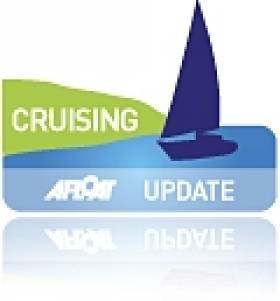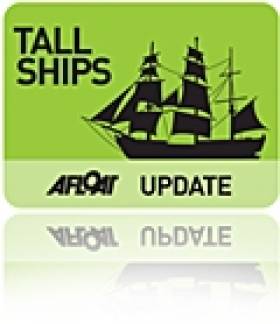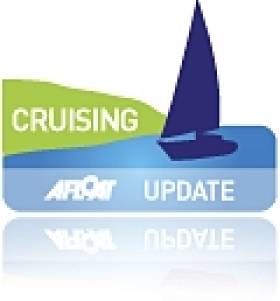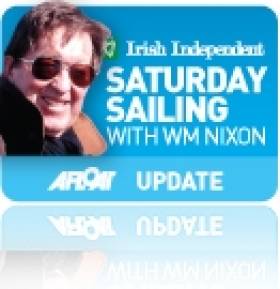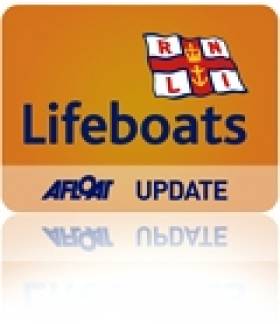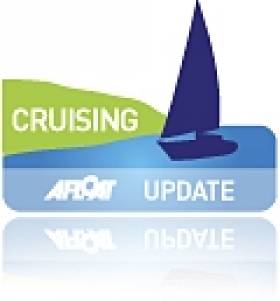Displaying items by tag: Cruising
#Cruising - The Cruising Association is set to launch a new section to cover activity in Ireland's busy cruising waters.
The London-headquartered organisation has set 19 October as the launch date for the new 'Celtic Seas' section, which will comprise the whole of Ireland plus the west coast of Scotland, the Isle of Man and the west coasts of England and Wales.
As Sail World reports, the proposed new section would complete the CA's coverage of the British Isles, along with the North Sea and Channel sections. Events and cruises-in-company would be arranged, not to mention the creation of a 'CelticNet' online forum for section members.
It's hoped that the Celtic Seas section would work together with existing cruising clubs and associations using the waters around Ireland - the Atlantic, North Channel, Irish Sea and Celtic Sea - to organise joint events, expanding on the CA's current presence in Ireland via honorary local representatives.
The first meeting of the Celtic Seas section will take place on Saturday 19 October at CA House in Limehouse, East London, where members of existing Irish and British west coast associations - and non-members with an interest in cruising - will be invited to discuss motor cruising and sailing in the region.
Sail Away From It All to The Western Isles, the Outer Hebrides
#hebrides – August is almost upon us. The heat has been fierce, and the summer season has been busy. Despite some blips in the weather, civilised folk will be thinking of sailing away from it all for a while. North and west perhaps, in the hope of finding uncrowded and beautiful places which may be cooler. The Western Isles, the Outer Hebrides, are calling us away.
Certainly they did so in August last year, but not for reasons of heat. On the contrary, the jetstream lay persistently along Ireland's south coast, and July's weather here was appalling. But the word came back that up in the Hebrides, they were already thinking of water shortages as the sun shone on and on.
We had contemplated taking the 1912-built 36ft Kearney yawl Ainmara to southwest Ireland for her Centenary cruise. But as owner Dickie Gomes is an enthusiast for the west coast of Scotland in any case, it was no contest. Twelve days in mid-August were allocated to celebrating the old girl's emergence from a 27-year restoration with some Hebridean island-hopping. And I became so taken with the idea that I made an offer that if we could get to the remote little pool of Rodel at the southern tip of Harris, I'd stand my two shipmates the Centenary Dinner at the inn beside that enchanted anchorage.
Rodel is a real honey-trap, as you need a good rise of the tide to get through the drying channel into the deep pool, and there you are - whether you like it or not - until the tide returns. But it's no hardship, as the place is beautiful, the inn is welcoming, and for a thoughtful insight into times past in the Western Isles, just up the road is the restored late mediaeval church of St Clement, complete with the famous MacLeod tomb with its carving of a sailing vessel, the inspiration for Wallace Clark's building of the Lord of the Isles galley with which he voyaged from Connacht to Stornoway.
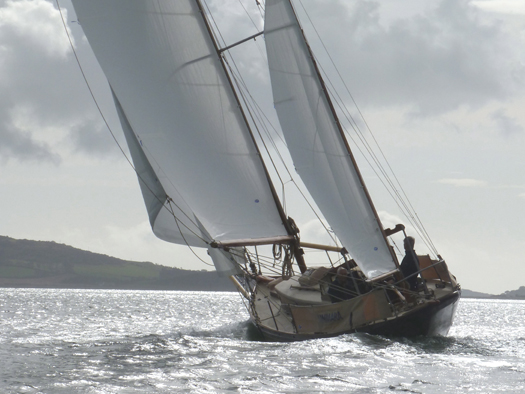 The Centenarian on a silver sea – after a restoration lasting 27 years, Ainmara deserved to spend her hundredth birthday at a very special place Photo: W M Nixon
The Centenarian on a silver sea – after a restoration lasting 27 years, Ainmara deserved to spend her hundredth birthday at a very special place Photo: W M Nixon
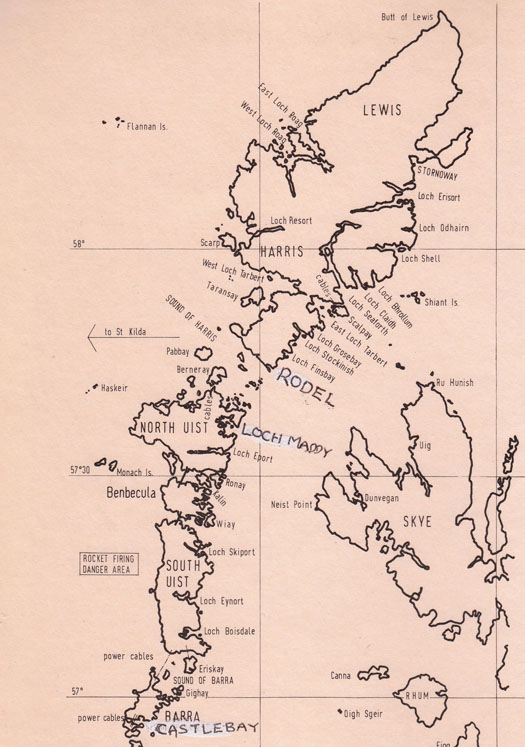 The cruise objective – Rodel is exactly in the middle of the long necklace of the Outer Hebrides
The cruise objective – Rodel is exactly in the middle of the long necklace of the Outer Hebrides
It's the sort of place that everyone thinks they are the first to discover, and my own first discovery of Rodel came in 1977 when we sailed in aboard Johnny Roche's 26ft South Coast OD Safina. The party in the inn was mighty, and dawn was already hinting when we struck a deal in the old kitchen to buy a bolt of Harris tweed, woven within sight of the anchorage. We sailed home with the tweed in a sailbag in the foc's'le, and two of the crew then commissioned that great Dublin tailor Jack O'Rourke (father of current Mermaid National Champion Jonathan O'Rourke) to make them up a couple of suits from our seafaring cloth.
Although they both were of much the same age, one was an old fogey from birth, while the other was a permanently young trendy. So when Jack finally produced the suits to their two very different and clearly defined specifications, it took a real effort to realize that both outfits were cut from the same piece of tweed, as one was a very sharp and fashionable bit of work, while the other had all the timeless style of a sack of potatoes.
Next time back to Rodel was six years later with my own Hustler 30 Turtle, and some of those good folk of Rodel with whom we'd partied in '77 had since gone to the great weaving mill in the sky, while the inn was running out of steam. It still clung to some semblance of gentility with immaculate table linen, but portions for dinner were of such modest size that we simply had two dinners apiece, one after the other.
That was all of thirty years ago, and since then the word was the inn had closed down completely. But a few years ago there was a welcome whisper of a restoration under completely new ownership. So when Ainmara's centenary came up the agenda, it seemed the perfect setting for a mid-cruise Centenary Dinner, and we departed from Ballycastle towards the sunny Hebrides with this interesting cruise objective in mind, while astern the Irish coast continued to lie under cloud.
Despite his impressive record of international long distance offshore racing, these days Dickie Gomes takes care to avoid unnecessary nights at sea, so our progress towards Rodel was gentle yet effective, hopping our way via Port Ellen and Ardbeg in Islay, then on to Scalasaig in Colonsay, and then out to Tiree to be nicely placed for the passage across the Sea of the Hebrides to Barra.
There'd been only one other yacht in Gott Bay in Tiree when we arrived, but there were half a dozen getting under way in leisurely style that morning. Ainmara was the only boat to head west out through Gunna Sound between Tiree and Coll into the Sea of the Hebrides, shaping our course for Barra and motoring gently through a large shoal of basking sharks going about their leisurely work. There was a strengthening breeze from the northeast and the soft grey cloud cover was melting away. It may have been three days already since leaving Ballycastle, but coming out through Gunna Sound gave a special feeling of the cruise really getting under way, and it settled into a perfect 40 mile passage, beam reaching in sunshine with everything set to the jib tops'l on its first outing, and the distinctive peaks of the southern outliers of the Western Isles starting to rise above the horizon while still thirty miles ahead.
 First port in the Outer Hebrides - Castlebay in Barra revelled in the August sunshine Photo: W M Nixon
First port in the Outer Hebrides - Castlebay in Barra revelled in the August sunshine Photo: W M Nixon
Castlebay basked in the sun, the heat was solid, and the tarmac on the quayside road was soft in the sun. At first we were in solitary splendour on the visitors mooring nearest Kisimul Castle, that ancient fortress of the MacNeils, but some other boats came in later in the evening. Up in the cool of the pub, glad to be out of the fierce sun, our gallant skipper met so many interesting folk that we were too late to get a booking at the funky little Café Kisimul on the quay, but had a reasonable meal in the hotel above the boat and retired aboard in a state of enchantment at being in the Outer Isles.
The morning brought a crisp easterly and hazy sunshine, so we were away early to make northing through the Sea of the Hebrides. We'd thought to drop into Eriskay for a lunch break, but the sailing was just too good, this was what we'd come for, we just kept going, and began to think that in a day or two we might even get to Rodel. Once the southeasterly headland on South Uist was astern, the sheets were eased and Ainmara settled into her stride with the jib tops'l pulling well, and the ancient mizzen staysail in its Killkenny colours of black and gold making its first appearance after a very long time in storage.
 This is what we came for – glorious sailing in the Sea of the Hebrides with the ancient mizzen staysail (in the Kilkenny colours) pulling well. Photo: W M Nixon
This is what we came for – glorious sailing in the Sea of the Hebrides with the ancient mizzen staysail (in the Kilkenny colours) pulling well. Photo: W M Nixon
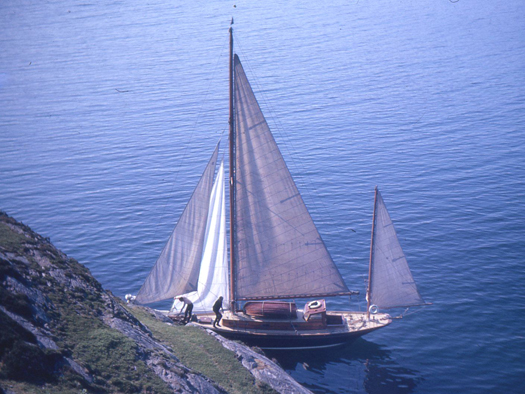 God be with the days.....Ainmara alongside the cliff at Loch Boisdale in June 1963 to collect a bunch of heather for the bowsprit end Photo: W M Nixon
God be with the days.....Ainmara alongside the cliff at Loch Boisdale in June 1963 to collect a bunch of heather for the bowsprit end Photo: W M Nixon
With progress like this, where on earth were we going to stop? Northward she romped, passing Loch Boisdale almost without a thought. Back in 1963 on our first cruise to the Outer Hebrides with Ainmara (when I already thought she was rather an old boat), one fine June morning we were gliding seawards down Loch Boiusdale, and noticed a healthy growth of heather on the nearby cliff. Once you've got north of Ardnmurchan Point, Scotland's Cape Horn, you're entitled to have a bundle of heather on the stemhead or bowsprit end. We hadn't yet got around to this back in 1963, but on that blissful morning we simply came alongside the steep shore, and nipped up the cliff to get the heather. It was Monday June 10th 1963. It was with some relief at the end of June that we noted the exact Golden Jubilee of that magic morning on Monday June 10th 2013 had passed entirely unmarked. You can have enough of Golden Jubilees.
Onward we sailed in August 2012 with gems of lochs like Eynort, Skipport and Uiskkevagh slipping by as this perfect day progressed. Flodday likewise was missed with cavalier disregard, then by Eport the wind was gone, but we motored on to Loch Maddy (48 miles from Castlebay) as we'd never been there before, and it left barely a dozen miles next day to Rodel.
We liked Loch Maddy, it's very Western Isles with the pier in one place and the village in another, and in the morning there was time for an heroic breakfast before heading down the loch in bright sunshine. There was a fine easterly breeze, and out in open water all plain sail was set and we started making impressive knots towards Rodel. I foolishly remarked that this looked like being the best sail of the cruise. Within minutes, it was as if somebody had knocked off a switch. We'd to motor for a while, then a gentle nor'easter had us beating in very leisurely style, and in mid-afternoon we were off Rodel with an hour or so to go to high water.
 While Loch Rodel itself provides only limited shelter, the pool behind Vallay Island is snug
While Loch Rodel itself provides only limited shelter, the pool behind Vallay Island is snug  The tidal entrance looks tricky enough, but it's worth it for the perfect anchorage within
The tidal entrance looks tricky enough, but it's worth it for the perfect anchorage within 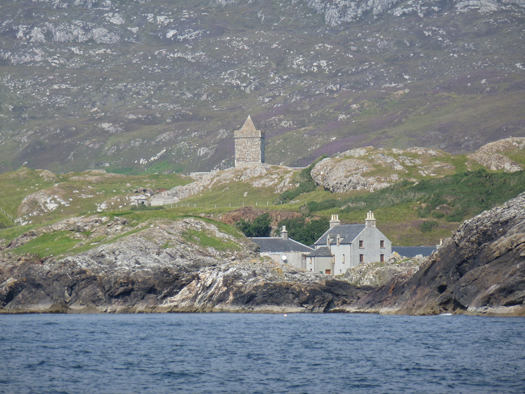 The shoreline begins to take shape, with St Clements Church clear above the hotel at Rodel Photo: W M Nixon
The shoreline begins to take shape, with St Clements Church clear above the hotel at Rodel Photo: W M Nixon
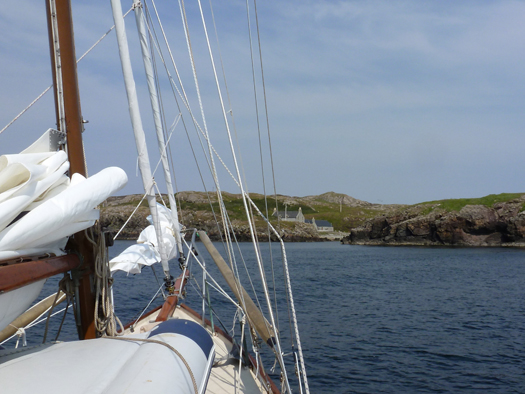 Ainmara is lining up for the Bay Channel into the pool Photo: W M Nixon
Ainmara is lining up for the Bay Channel into the pool Photo: W M Nixon
 The seabed is clearly visible as you pass through the channel close to the port hand marker Photo: W M Nixon
The seabed is clearly visible as you pass through the channel close to the port hand marker Photo: W M Nixon
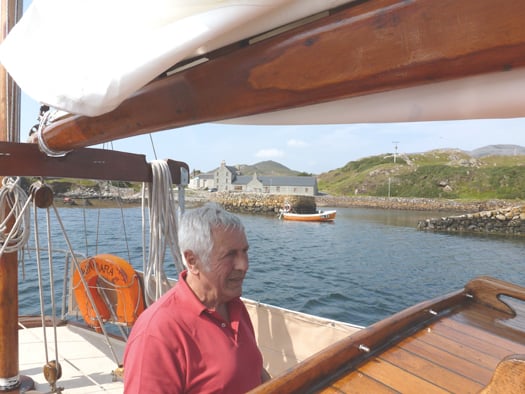 A very relieved skipper as we start to find deeper water in the pool Photo: W M Nixon
A very relieved skipper as we start to find deeper water in the pool Photo: W M Nixon
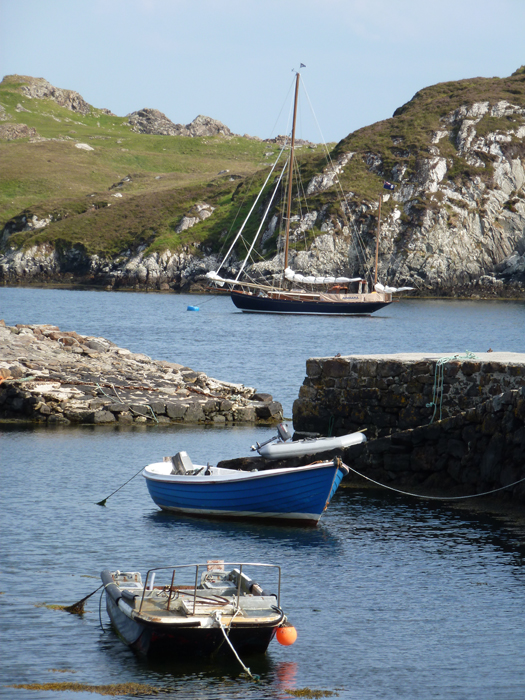 Mission accomplished – Ainmara in Rodel to celebrate her Centenary Photo: W M Nixon
Mission accomplished – Ainmara in Rodel to celebrate her Centenary Photo: W M Nixon
But as tides were neaps, the skipper was a bit nervous as we found our way through the shoal entrance in gentle style. You really do pass very close to the port hand marker. Yet once within the pool, my shipmates saw why I was so keen about this enchanting place, and we happily slowed down to Rodel speed for the rest of the day.
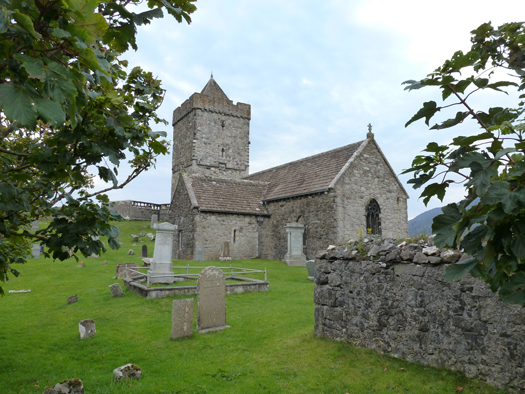 St Clement's Church at Rodel is one of the Outer Hebrides more significant buildings Photo: W M Nixon
St Clement's Church at Rodel is one of the Outer Hebrides more significant buildings Photo: W M Nixon The historic Macleod tomb in St Clement's Photo: W M Nixon
The historic Macleod tomb in St Clement's Photo: W M Nixon
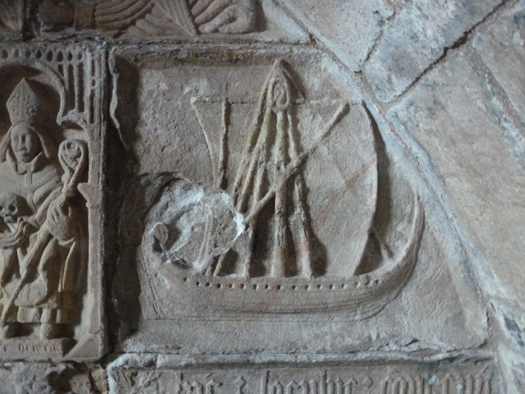 The stone carving on the MacLeod tomb which inspired the Lord of the Isles galley to be built in Greencastle in Donegal Photo: W M Nixon
The stone carving on the MacLeod tomb which inspired the Lord of the Isles galley to be built in Greencastle in Donegal Photo: W M Nixon
Ashore, a visit to St Clements Church fitted the mood perfectly. There is a genuine sense of the past, and of the turbulent history which had once been the lot of this sleepy and now remote place. Down at the restored inn (it's called the Rodel Hotel these days, but for me it will always be the inn), we found the sympathetically-renovated establishment had a new dining room beside a new bar – the old rough bar out the back where we'd started negotiating for the tweed was long gone. And though the Countess of Dunmore's drawing room cum dining room where we'd enjoyed fine linen still exists, it is boarded up. But everything else is very much alive, we were able to have luxurious baths in Jock's Room (thanks Jock) and the setting was perfect with the evening sun still bright on the Centenarian sitting gracefully on her mooring and well visible through the restaurant windows, while the food aspirations were up to speed with a German chef and a friendly and obliging Spanish husband and wife couple front of house.
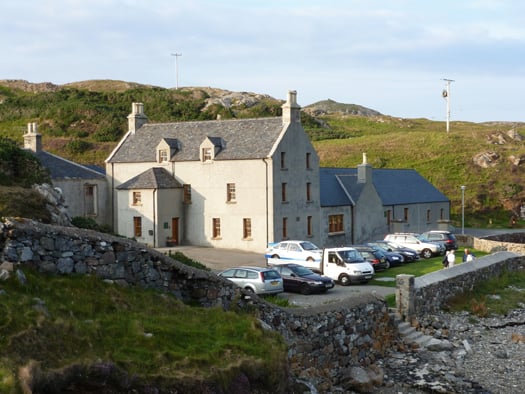 The Rodel Hotel has been restored in a manner which respects its original style. Photo: W M Nixon
The Rodel Hotel has been restored in a manner which respects its original style. Photo: W M Nixon
Appropriately, the skipper had the best of it - he went for the surf'n'turf option which was far from your usual beef and salmon, it was Pabbay venison from the second-last island before St Kilda, combined with Sound of Harris hand-caught scallops. It sounds a bit overpowering, but worked very well, and kept himself in the best of spirits. Denis our third crewman being a sports addict, he was keen to see the Olympics Closing Ceremony on television after dinner, and we were invited to use the Residents' Lounge to do so in comfort. While the lads were settling themselves in there with the coffees and digestifs, I nipped furtively up to the bar to settle the bill - the other two hadn't really believed my "get to Rodel and I'll pay for dinner" proposal - and found what was clearly the man himself running the bar and everything else.
"Would you be our host?" I enquired. "I am indeed," said he, "for my sins I'm the proprietor of this place. Welcome to Rodel. I'm Donald MacDonald".
Such is life. We go all the way, nursing an old boat across hundreds of miles of potentially very turbulent water to Rodel in the Western Isles in order to celebrate her Centenary Feast in the Great Hall of the MacLeods of Harris, only to find it has become a MacDonald's.
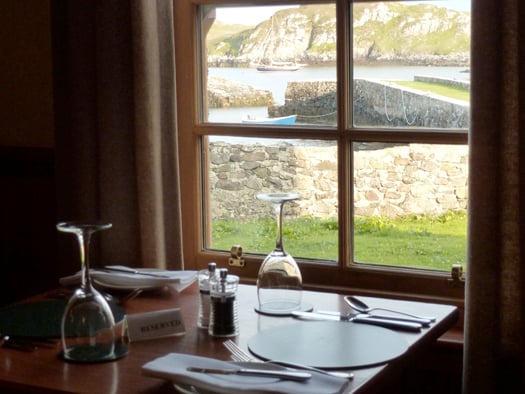 A MacDonald's with a difference – Ainmara serene in the evening sunshine at Poll an Tigh-Mhail, seen from the dining room in the Rodel Hotel. Photo: W M Nixon
A MacDonald's with a difference – Ainmara serene in the evening sunshine at Poll an Tigh-Mhail, seen from the dining room in the Rodel Hotel. Photo: W M Nixon
Celtic Mist in Dun Laoghaire Ready For Gathering Cruise
#CelticMist - The Irish Whale and Dolphin Group's (IWDG) research yacht Celtic Mist is currently docked in Dun Laoghaire awaiting the start of The Gathering Cruise around Ireland.
As previously reported on Afloat.ie, the 19-day event will see some 100 cruising boats proceed along the east and south coasts of Ireland from Dublin to Cork and Kerry.
Along the way they will be recording any sightings of whales or dolphins along the way using forms supplied by the IWDG.
Celtic Mist will join the flotilla as it departs Dun Laoghaire Harbour on 18 July headed for Kinsale on 24 July, and a second leg from Kinsale to Dingle from 25 July to 1 August.
And the IWDG is currently offering places on board to all members for both week-long legs of the cruise.
The vessel has eight berths that will comfortably sleep a team of one skipper and seven crew - indeed, anyone taking up this offer will be expected to prepare meals and perform other sailing duties!
For more details on how to join The Gathering Cruise on board Celtic Mist, see the IWDG website HERE.
In the meantime, Celtic Mist is offering all IWDG members a chance to sail on day trips from Dun Laoghaire this week - email [email protected] for details.
Big Decline In Shannon Passages Over Last 10 Years
#Shannon - Passages on the River Shannon in 2013 so far have fallen more than 50% compared to numbers for the same period a decade ago, according to the Irish Waterways History blog written by Afloat's inland correspondent, Brian Goggin.
Using statistics supplied by Waterways Ireland, the site plotted a graph that shows an overall decline in lock and bridge passages on the Shannon in the months from January to May each year since 2003, with a slight spike in 2007 the only buck in the downward trend.
Though the figures do not record all uses of the waterway (such as sailing, angling and other watersports) and do not account for variables such as the weather, they are indicative - the site claims - of "the Shannon's most significant tourism activity, the cruiser hire business".
Indeed, the figures apparently show that boat hire passage numbers have fallen from 11,440 in January-May 2003 to just 4,781 in the same months this year.
Even private boat passages have been falling from a peak in 2009 to just below their 2003 numbers, if the site's interpretation of the stats is anything to go by.
However, a source close to Afloat.ie says that the falling numbers may be skewed by a growing emphasis on larger-capacity vessels on Ireland's inland waterways, with eight- and 12-berth boats supplanting older four-berth vessels, and families and groups consolidating their recreational boating.
It will be interesting to see how the rest of the year turns out, and whether the overall numbers from January to December will tell a different story of the state of the Shannon and other waterways.
Sailing Cruise Through the Baltic in Summer 2014
#baltic – Cruising rally specialists World Cruising Club (WCC), have announced an exciting new addition to their rally programme, with the first ever ARC Baltic Rally planned for summer 2014. Billed as "six capitals in six weeks" the new rally will offer a different focus from the trans-ocean events, for which WCC is best known. A combination of days cruising at sea, combined with an exploration of the region's fascinating culture and history, will take cruisers on a 1,500nm voyage of discovery through Europe's "east sea".
Andrew Bishop from World Cruising Club commented on the new rally. "We've often had requests from previous ARC participants for a Baltic cruise. Now, having proved with the popular Malts Cruise in Scotland, that the rally format of easy cruising, cultural and social activities, together with a lead-boat works well, I felt the time was right to go further east. The Baltic is a vast waterway which offers some superb sailing, and the added attraction of a unique and varied history, makes it a perfect place to cruise." Discussing the organization of the route, he continued "By having a lead-boat with an experienced Baltic sailor aboard, we can provide guidance and assistance all the way along the route, right into St. Petersburg!".
Starting from the Baltic port of Kiel, the home of German sailing, the ARC Baltic itinerary will include the Estonian capital Tallin, the former Russian Imperial capital St. Petersburg, the Finnish capital Helsinki, the Finnish provincial capital Mariehamn, the Swedish capital Stockholm, and the Danish capital Copenhagen. En route, the rally sails through some of the most beautiful and interesting sights in the Baltic. The rally format will be adapted to the Baltic and the individual legs will be short, one to two days, with the focus being to experience the cultural history of the region and enjoy the stunning beauty of the Swedish and Finnish archipelagos. Over six weeks the rally will sail close to 1500 nautical miles, with an itinerary that allows flexibility for the prevailing weather encountered. The start is planned to be in mid-July to be finished by late August, allowing yachts from further afield to be back to their home ports by the end of the month. World Cruising Club will lead the rally from onboard a yacht sailing with the fleet, with an experienced Baltic sailor and historian as guide.
At this stage World Cruising Club is taking expressions of interest for the first rally to be run in the summer of 2014.
#Safety - The deaths of a mother and daughter in Britain's Lake District have highlighted the need for awareness of the risk of carbon monoxide leaks on cruisers and other vessels with sleeping berths.
As The Guardian reports, 36-year-old Kelly Webster and her 10-year-old daughter Laura Thornton died in their sleep on board a moored motor cruiser in Lake Windermere over the Easter bank holiday.
The interim report into the incident by the UK's Marine Accident Investigation Branch (MAIB) released this week confirms that fumes from a jury-rigged generator exhaust spread into the cabin of the boat belonging to Webster's partner Matthew Eteson, who survived.
It was also pointed out that the boat's carbon monoxide sensor did not set off an alarm because it was not connected to a power supply.
The boat had been installed with a portable petrol-driven generator of the kind normally only intended for use in the open air.
"The use or permanent installation of these engines on boats, particularly in enclosed spaces or below decks, increases the risk of carbon monoxide poisoning," the report added.
Just a week after the tragedy, BBC News reported that a woman and two children were taken to hospital to be treated for suspected carbon monoxide poisoning after a similar incident on a boat on the same lake.
Following the latest news, Bord Gáis Networks has provided guidance for keeping aware of the dangers of fumes from gas or fuel-powered generators, heaters or cookers.
Boaters are urged to think of the appliances on their vessels and whether they burn fuel oil, gas, LPG, wood or coal, which all produce carbon monoxide by burning.
Carbon monoxide becomes a hazard when there is not enough air flow to burn the fuel properly - more likely in an enclosed space such as a boat cabin - so ventilation is very important.
Make sure all flues and exhaust outlets are clear and ventilated, and ensure any appliances used are suitable for boats and serviced annually by a qualified agent.
Boat-owners are reminded of the good practice of installing a carbon monoxide alarm, and to know the signs of carbon monoxide poisoning - which include headache and dizziness, leading to loss of judgement, nausea, possible convulsions and elevated heartbeat.
ARC Sailors Give Thumbs Up to Cape Verdes Route
From the pre-departure programme ensuring crews are relaxed and prepared, to the friendly welcome each boat receives on arrival in Saint Lucia, the unique spirit that surrounds the ARC each year has meant the Rally is firmly on the 'bucket list' for cruising sailors. Since its creation almost 30 years ago, World Cruising Club has built on these key strengths and provides a safe and social event that annually attracts hundreds of cruising boats to cross the Atlantic with the help of their expert organisation.
In 2013, demand to join the ARC has been unprecedented and World Cruising Club have announced the addition of a new route option for the world's most popular cruising rally, to give even more dedicated cruising sailors the chance to join the transatlantic rally of choice and offer a new experience for returning participants keen to expand on their previous crossings. ARC+ Cape Verdes will depart Las Palmas on 10 November, 2 weeks earlier than the traditional start, and feature a 3-5 day stopover in Mindelo, Sao Vincente, before continuing with the trade winds to Saint Lucia. The rally has already proved extremely popular and entries are expected to reach capacity 50 boats in the coming weeks.
The new route retains the pedigree of the ARC whilst offering a new adventure. "We feel like pioneers!" said Gill and Colin Nobbs who quickly signed up their Moody 42 Resolute of Thames to join the first ever ARC+, and many returning crews have welcomed the stopover in the Cape Verdes as a chance to explore somewhere new. The islands are perfectly placed to 'sail south until the butter melts' and an exciting programme of events will be arranged during the stopover to introduce crews to the Cape Verdes culture and scenery. The earlier departure from Las Palmas means that despite the stopover, ARC+ boats are due to arrive in Saint Lucia during the first week of December, allowing time for crews to enjoy the famous welcome celebrations and parties before some extended Caribbean cruising.
Each year, World Cruising Club ensure hundreds of yachts enjoy a safe passage across the Atlantic providing advice and support for skippers and crews from the moment their preparations begin. ARC participants become a family before the pre-departure schedule even starts; often meeting one another in marinas on the way to the Canaries, where significant discounts are available, or introducing themselves through the radio net, online blogs and dedicated facebook page. The Rally Handbook, available to skippers and crew six months prior to departure, combines cruising and safety knowledge gathered from over quarter of a century of running transocean rallies and the World Cruising Club team, all of whom are passionate sailors, are always happy to talk about any aspect of life at sea at seminars, boat shows and from our offices across Europe, in the USA and Australia.
Dunmore East: A Suitable Harbour for a Marina?
Dunmore East is a charmingly located and picturesque coastal village, whose enormous potential as a holiday and maritime centre is blighted by having an outdated and rather drab industrial zone at its core. For it has the misfortune to be trapped in its historical position as a long-established fisheries port. This means that the administration of the harbour – which should be the pleasant heart of the village – has been rigidly strait-jacketed into serving and promoting the demands of the fishing industry, often to the exclusion and certainly the detriment of the possible needs of any other potential harbour users, both afloat and ashore.
Were Dunmore East located on another part of Ireland's coastline, this might not matter too much. But the village is a popular holiday resort, and the harbour is in an absolutely key strategic location at local, regional, national and international levels in recreational boating. It is at the heart of a fine sailing area which – if there were proper berthing facilities available – would be ideal for hosting major events. An immediate example is the ICRA Nationals. Dunmore East would be a perfect location for this national annual cruiser-racer championship, yet there's no way it will be considered until the harbour is more welcoming to recreational boating.
But not only is Dunmore a potential venue port, it is the gateway to the largely untapped cruising potential of Waterford Estuary, and the Suir, Barrow and Nore rivers. In any other country in the world, this beautiful cruising land of the Three Sisters would be perceived as a national treasure. But in Ireland it is still receiving only minimal attention because the key to the whole place, the gateway port of Dunmore East, has not been welcoming.
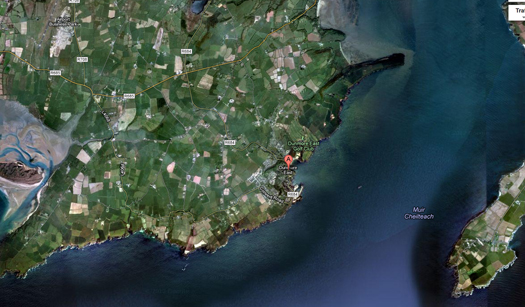
Dunmore East is both the heart of the coast, and the gateway to the magic cruising area of the Three Sisters - the estuaries of the Rivers Suir, Barrow and Nore. Photo: Google maps
Looking at the broader picture, Dunmore East's inhospitality affects the movement of cruising boats sailing along the coast. The large boat populations of the Irish Sea are discouraged from making the lengthy passage to the prime cruising areas of West Cork and Kerry because they're put off by knowing that if the urgent need arises, a visit to Dunmore East might not be a pleasant experience. Were the opposite the case, there would be an increase in the number of boats cruising the Irish coast generally. And a good experience in Dunmore East would also encourage them to sample the unexpected delights of cruising up to Waterford City or the port of New Ross, and visiting places little known to cruising men such as Duncannon, Arthurstown, Ballyhack and Cheek Point, not to mention the quiet anchorage behind Little Island in King's Channel.
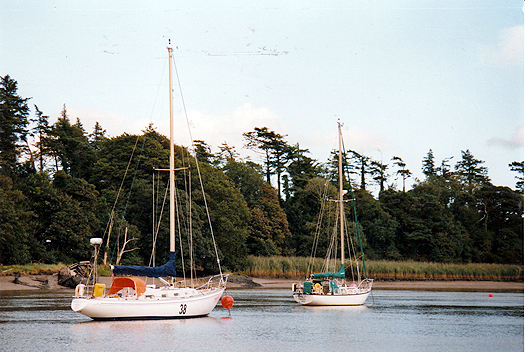
One of the Waterford Estuary's little known anchorages is in Kings Channel behind Little Island immediately east of Waterford City. Photo: W M Nixon
But you get only one chance to make a favourable first impression, and in recent years Dunmore East has been failing to do that. One of the saddest things about the place is the Visitors Book in the hospitable Waterford Harbour Sailing Club. Time was when each summer would produce a long list of the crews of visiting boats from near and far, and their enthusiastic comments. But these days the list has reduced to a trickle as the increasingly hostile demands of the harassed fishing industry have made the harbour bad-tempered, a place to be avoided.
Yet just along the coast, 15 miles to the eastward beyond Hook Point, there's a smaller port which manages to be both a thriving fishing port, and a welcoming marina. Kilmore Quay misses almost all the natural advantages of Dunmore East, as it's on an exposed and rocky coast. But it has just about everything else that Dunmore East lacks – it has enthusiasm, visible hospitality, and a can-do approach for boats of all sorts. So though it has the disadvantage that once berthed there, there is little you can do except stay put if the weather deteriorates, in every other way Kilmore Quay is streets ahead.
This is surely because Kilmore Quay is owned and run by Wexford County Council. With a vigorous council, enthusiastic county managers, and an energetic harbour master whose brief extends well beyond the stultifying limitations of the Department of Fisheries, Kilmore Quay is very much alive, while Dunmore East is moribund.
This would be fine if Dunmore East continued to be a major fishing port, but that's now a moot point. Fishing is becoming more truly industrialized by the day, and big boats with highly automated equipment and smaller crews are taking over the most profitable parts of the business. A port like Dunmore East, with its small size and draft limitations, is increasingly by-passed by the major operators. For sure, there'll always be fishing out of Dunmore East, but with an inbuilt boat size limitation it will increasingly be towards the artisan end of the fishing industry.
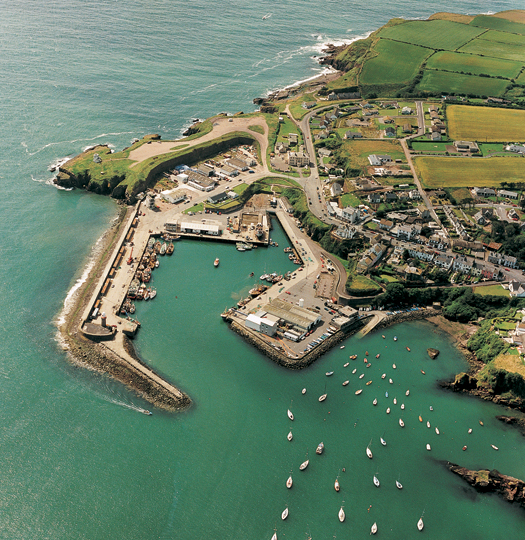
Dunmore East looking south, with Gull Rock lower right hand corner. In a southwesterly breeze, the anchorage is well sheltered, but it can become uncomfortable and even dangerous in southeast to east winds. Photo: Kevin Dwyer
Currently, Dunmore East has probably now slipped beyond fourth place in the Republic of Ireland in terms of fish landings by weight. You get the picture from the 2010 figures by realising that at 163,447 tonnes, Killybegs outstrips all other significant Irish ports combined. Next in line is Castletownbere with 19,030 tonnes, while Dingle is third at 12,761. Although in 2010 Dunmore East was fourth at 8,387 tonnes, in terms of value it was outstripped by Kilmore Quay – Dunmore's landings were worth €13.6m, but Kilmore went for quality, and they got €13.7m for their 3,260 tonnes.
And as Kilmore Quay has more in the way of fish processing plants, the value-added element to their smaller but higher quality catch is also greater than Dunmore East's. In Dunmore East, the continuing encroachment by the needs and expectations of the modern shore-based holiday market means that property is more profitably utilised if it's catering for the personalised needs of the hospitality industry, rather than as an impersonal industrial unit, particularly one with the anti-social aromas of fish processing.
This decline in the fishing industry status of the long-established smaller ports is a European-wide problem, and a new inititative from Brussels seems to offer an opportunity for Dunmore East to be a suitable case for treatment, as interestingly revealed HERE.
Although it all still requires confirmation from the European parliament, many of the EU's maritime nations such as Portugal are quite far down the line in planning projects which will take full advantage of this "post-fishing" scheme, which will involve some quite serious money to be available between 2014 and 2020.
But however obvious the benefits which could accrue to Dunmore East, the rejection by the locals of a major harbour improvement project some years ago (it was to include a marina) has muddied the waters for future projects. The older generation in Dunmore East probably reckon they've accommodated enough change. Though the present layout will seem to today's generations to be a permanent feature of the environment, there are still many around who can well remember the massive re-vamp of the harbour when it was being undertaken by the OPW during the 1960s. It was meant to take about five years, but it took eleven. And at the end of it, the pleasant little cove of Dunmore, sheltered by an elegant pier designed in 1814 by the harbour genius Alexander Nimmo, had been changed greatly, with a breakwater extension going out beyond the pier, while within there was an enormous new concrete apron quay on a site brutally blasted out of pretty cliffs. Despite which, the kittiwake, most unusually nesting on cliffs which had become a central part of the village, had stayed on despite a decade of dynamite.
The kittiwakes may have stayed on, but big fishing is going from Dunmore East. So how best to change the harbour for continuing viability, without destroying the much-loved character of the place, while at the same time profitably accomodating all possible harbour users?

Dunmore East as it will be in the summer of 2013, with the new 40–metre pontoon indicated under the lighthouse on he outer pier. The anchor (top) indicates the anchorage in offshore winds off the Strand Hotel. Plan courtesy Irish Cruising Club
This year will see a small step towards providing berths for visiting cruisers. It's indicated on this latest ICC plan, and will be a 40 metre (120 feet) pontoon running lengthwise along the quay down towards the end of the pier, near the old lighthouse. Access ashore will be via steps that are let into the quay, and it's reckoned that up to twelve boats of average size can be accommodated. Every journey starts with a first step, but this particular first step by its location will require a lot of steps - in fact, route march is more like it - as it's about as far as you can be from the Sailing Club and the village without actually starting to depart from the harbour again.
Welcome as this pontoon is, there's a risk that it might serve as a distraction from more imaginative action, and already there is another quayside pontoon in the southwest corner of the harbour for Dunmore East's many half-deckers. But here at Sailing on Saturdays, we'd suggest that to be of any real value, Dunmore East harbour needs more radical action, and our harbour design department has been busy.
Any modification of Dunmore East harbour for use by craft of all sizes, and mostly smaller than today's average fishing boat, must take account of the fact that, in severe southeasterly gales, the outer parts of the harbour are extremely exposed. Up in the sandy cove off the Strand Hotel, where the ICC sailing directions quite rightly suggest anchoring if the wind is pleasantly between southwest and northwest, it is well known to YouTube viewers that a southeasterly gale (such as occurred on 15th August 2012) can produce impressive onshore breakers going clean over the inn. It's bad enough in a summer storm, and as for winter... in winter – when the traditional fishing season used to be at its height – Dunmore East could fill up with visiting Dutch boats, and after a period of severe southeasters the hotelier at The Strand went up to check his roof, and in the middle of it found a traditional Dutch wooden clog, swept in from the sea and popped up there by a mighty breaking wave.
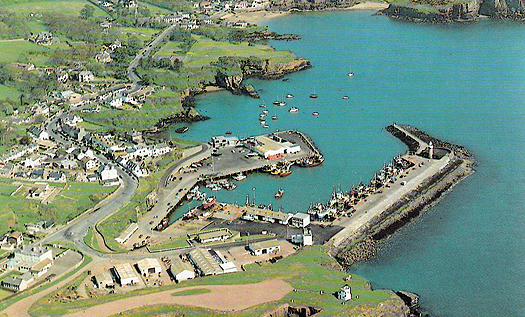
Dunmore East as seen from the southeast, with the Strand Hotel at top of photo. Photo: Rex Roberts
When the Strand Hotel is building up its clog collection in sou'east storms, there's quite a scend which can snake its war round the corner and into the harbour. And of course any yachts lying on the WHSC mooring immediately northwest of the harbour are having a very rugged time indeed. So the suggestion here is that we modify the harbour entrance to keep that scend at bay, and at the same time extend the Gull Rock through the current moorings to provide well sheltered space immediately northwest of the WHSC clubhouse.
The first step in this project would be lengthening the extension to the Outer Pier. Every time you see the place in rough weather, you can't help but think that the engineer in the 1960s would probably have liked to make it twice as long in the first place. But if we're going to have our new breakwater coming along the line of the Gull Rock, in order for it to be long enough to be effective without closing the harbour mouth too much, we have to angle the new outer breakwater extension in a slightly more northerly direction. Not much, but enough to make all the difference to the channel room in the harbour entrance.
The Gull Rock Breakwater is envisaged as being just that – a breakwater. It will have to be about a metre above High Water Springs, otherwise people will try to go over it as they do with the North Bull Wall in Dublin Bay. But the concept is that it's a breakwater and nothing more – no promenade along the top, and preferably made of rock armour to chime with the Gull Rock, though cost may make it necessary to build in tetrapods.

Thinking outside the box – Sailing on Saturday's line of thought for Dunmore East. The new breakwater suggested along the Gull Rock would simply be a breakwater, without a walkway along the top. Drawing by Afloat Studios.
With the extended outer pier and the new Gull Rock breakwater, a well-sheltered area is created for the installation of a marina. That's the beauty of a marina. All it needs is an area of sheltered water with the required depth, and just one single point of shoreside access. There's no need for expensively finished quay walls - a marina is a minimalist installation, and extremely good value once the space has been created.
We appreciate that there will be those who'll be horrified by the thought of any part of that pretty little coastline between the harbour and the Strand Hotel being enclosed behind a breakwater. But we'd emphasise that, as far as possible, the breakwater will be made to seem like a natural extension of the Gull Rock. And while Stony Cove and Badger's Cove will be within the new sheltered space, important locations like Men's Cove (Poul na Leenta) and Lady's Cove will be kept nice and fresh outside.
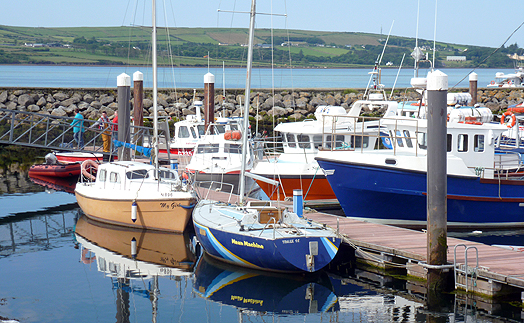
This newer marina for smaller local craft in Dingle suggests a welcome level of co-existence between all types. Photo: W M Nixon
With the marina in place, the entire dock area can revert to being exclusively for fishing boats. But with the industry being rationalized into a more compact shape these days, in time there could well be space for hauling out all boats and other manner of marine work taking place in there. Who knows, but maybe those pontoons running along the quays in the northeast and southwest corners of the harbour – a hugely wasteful use of quay space - might themselves become unofficial little marinas. I found one such in an eastern corner of Dingle Harbour last summer, and it seemed to be working in a harmonious way to accommodate boats of very different type and purpose.
Well, there you have it – it's one idea for Dunmore East, doubtless there are many others. And although Sir Boyle Roche may have quite rightly opined that we should do nothing for posterity on the grounds that posterity have done nothing for us, for the sake of future sailors let us at least take note that the clock in Brussels is ticking, and the train with these new funds will soon be leaving the station.
Comment on this story?
We'd like to hear from you! Leave a message in the box below or email William Nixon directly on [email protected]
WM Nixon's Saturday Sailing blog appears every Saturday on Afloat.ie
Follow us on twitter @afloatmagazine and on our Afloat facebook page
Busy Saturday for RNLI on Lough Derg
#RNLI - Lough Derg RNLI launched twice yesterday (21 April) on consecutive callouts to a vessel grounded at the Corrakeen Islands and a sinking cruiser at the northern end of the lake.
Around 3.45pm yesterday, Valentia Coast Guard requested the launch of the Lough Derg RNLI lifeboat to assist three people on board their 20ft cruiser after their engine failed and were pushed on to rocks by the Corrakeen Islands in Dromineer Bay.
Helm Eleanor Hooker with Ger Egan and Tom Dunne set out in winds blowing south westerly, force 3 and gusting 5, and the lifeboat was alongside within half an hour of launch.
The two adults and a young child on board were unharmed but extremely anxious. They had dropped anchor to prevent further grounding and breakage.
An RNLI crew member was transferred to their boat to assess for damage and, very quickly - once it was established that the vessel was not holed - set up for a tow, weighed anchor and the lifeboat took them off the rocks and out into safe water.
The lifeboat then towed the boat with her crew (and the RNLI volunteer still on board) to Dromineer Harbour, where RNLI shore crew were waiting to take lines and help.
Lough Derg RNLI crew member Ger Egan advised that said anyone taking their boat afloat after the long winter should "make sure that their engines are fully serviced and make sure to use new fresh fuel".
Later that afternoon the lifeboat launched again to assist two people who had taken to their liferaft as their cruiser was sinking.
The exact location of the 28f cruiser was not certain, but once the lifeboat crew were informed that the cruiser had set out from Terryglass at the northern end of the lake, an half hour earlier they were able to accurately estimate the liferaft’s current location.
At 5.50pm the lifeboat launched with helm Eleanor Hooker, Peter Clake and David Moore on board. Winds were south westerly, force 4, gusting 6.
The lifeboat located the cruiser and the liferaft north of Coolbawn, south of Gortmore, on the eastern shore of Lough Derg, and was alongside by 6.15pm, The two people on board were unharmed, but the skipper was greatly distressed.
He had inadvertently veered off course and had glanced off a rock and holed his boat. A passing 18ft speedboat with two people on board also came alongside and gave assistance.
Two lifeboat crew members helped the people from the liferaft and onto the speedboat, which had a canopy and offered shelter from the wind. They gathered the liferaft and its contents into the cruiser cabin and, as the cruiser was rapidly taking water, they weighed anchor so that the lifeboat could beach the vessel and reduce risk of further damage.
Once beached, the lifeboat crew dropped anchor once more, and especially as the winds were forecast to get up in the night. There was no evidence of fuel leakage and arrangements were made for the vessel to assessed and recovered this morning.
The lifeboat and the speedboat, with the two casualties on board and under cover, then made way to Garrykennedy where friends were waiting to look after them.
Eleanor Hooker thanked Cillian Boyle, the helm of the speedboat, for his kind assistance and commended her crew for their "kind consideration of the casualties and their calm professionalism in dealing with the fraught situation".
Shipwreck Highlights Danger of Portugal's Winter Winds
#Shipwreck - Two are reported dead after a shipwreck yesterday (Wednesday 10 April) on the Portuguese coast in what is a reminder to all cruisers of the dangers of strong winds in the region.
According to Portuguese language newspaper Publico, the deceased include one of the five crew of the German-flagged cruiser Meri Tuuli, and a member of the Portuguese maritime police attending to the incident who went into the water when his RIB overturned.
Eight people in total were admitted to hospital after the incident in which the Meri Tuuli - an X-442 yacht perated by a local sailing school - capsized on Cabedelo beach in Figueira da Foz, near Oporto.
Two are reported to be "wounded with traumatic injuries" while another two showed symptoms of hypothermia after exposure to the water.
Figueira da Foz is a popular cruising destination along the Iberian coast, but its port is vulnerable to the high swells that attract surfers to the area, sometimes closing altogether.
A source close to Afloat.ie described most harbour entrances along Portugal's west coast as "lethal during of after strong winter south or southwest winds" which are made stronger as air rushes into the valleys at river mouths as sea breezes.



























